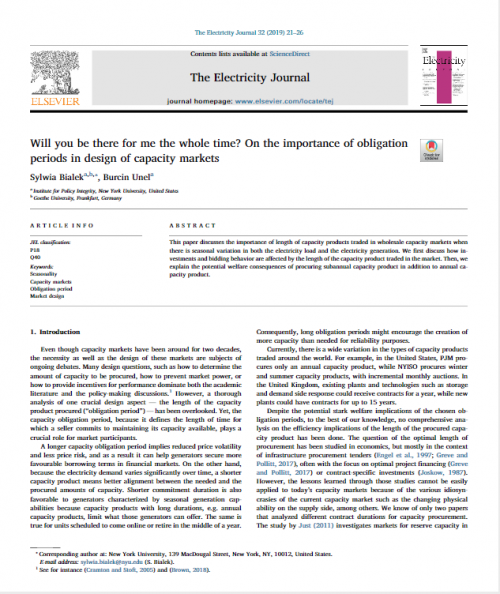-
Will You Be There for Me the Whole Time?
On the Importance of Obligation Periods in Design of Capacity Markets
This paper discusses how variations in the availability of various resources (generation seasonality) and the fluctuations in the electricity usage (load seasonality) relate to efficient capacity market design. Even though capacity markets have been around for two decades, the necessity as well as the design of these markets are subjects of ongoing debates. Many design questions, such as how to determine the amount of capacity to be procured, how to prevent market power, or how to provide incentives for performance dominate both the academic literature and the policymaking discussions. Another design aspect that plays a crucial role for market participants is the length of the capacity product procured (“obligation period”), because it defines the length of time for which a seller commits to maintaining its capacity available. However, a thorough analysis of obligation periods has been overlooked by literature and policymaking discussions. Our article works to provide this analysis.
-
Comments to FERC on NYISO and Energy Storage Resources
A new wholesale energy market policy proposal in New York could undermine market efficiency by limiting the compensation available for energy storage resources. The New York Independent System Operator (NYISO) recently submitted changes to its market rules to encourage energy storage, as required by an order from the Federal Energy Regulatory Commission (Order No. 841). The filing prevents energy storage resources from participating in the wholesale markets if they also participate in retail compensation programs. We submitted comments explaining how this participation barrier is inconsistent with FERC’s requirements and should be changed.
-
Comments on FERC’s Potential Reforms to PJM Capacity Market
After suggesting that state policies subsidizing clean energy are distorting capacity markets, the Federal Energy Regulatory Commission (FERC) is exploring reforms to the capacity market in PJM – the grid operator serving 13 states and Washington D.C. FERC’s reforms have the potential to undermine state policies that address climate change, such as Renewable Energy Credits and Zero Emissions Credits (we discuss this issue in depth in a recent report). We submitted comments to FERC and reply comments on the proposals.
-
Comments on New Jersey’s Energy Master Plan
New Jersey is revising its Energy Master Plan (EMP) for 2019. In advance of the first draft of the plan, the New Jersey Board of Public Utilities, along with other state agencies, formed a committee to engage with stakeholders on the contours of the new plan. We submitted comments to the EMP Committee with a number of recommendations. Specifically, in drafting the 2019 EMP, we advise the Committee to consider grid resilience in a holistic manner and apply cost-benefit analysis to resilience plans and investments; adopt a granular approach to rate design, rather than use net metering; and design an incentive structure for energy storage operators to ensure that the use of energy storage systems reduces greenhouse gas emissions. These recommendations draw upon several of our recent publications on electricity policy, including reports on grid resilience and energy storage, and an academic article, also on energy storage. The first draft of the EMP is scheduled to be released this winter.
-
Comments to the California PUC on Energy Storage
We recently submitted comments to the California Public Utilities Commission on the Self-Generation Incentive Program (SGIP). Retrospective review of SGIP has found that, contrary to the program’s goals, greenhouse gas emissions sometimes increase when energy storage systems are deployed. To address this unintended consequence, the CPUC Energy Division Staff issued a set of recommendations on how to improve the program, including by creating a real-time greenhouse gas emissions factor for energy storage operators to use, and by tying the SGIP incentive payments to greenhouse gas performance. Our comments provide the CPUC with our original analysis on energy storage to support these recommendations, including our recent report, Managing the Future of Energy Storage, and an academic article, by Policy Integrity’s Director, Richard Revesz, and Energy Policy Director, Burcin Unel, Ph.D, on energy storage and greenhouse gas emissions.
-
Comments on Vermont’s Standard Offer Program
We recently submitted comments on Vermont’s standard offer program, which is designed to support smaller-scale renewable energy projects. One component of the standard offer program compensates generators that provide benefits to grid operation and management. In the past, the Vermont Public Utilities Commission has focused its view of these benefits to reward only generators that relieve transmission constraints. However, our comments urge the PUC to take a broader view of benefits to grid operation and include resilience benefits and avoiding climate effects on the grid. We cite our July 2018 report, Toward Resilience, to give the PUC more guidance on how to think about and value grid resilience. We also recommend that, when more broadly assessing the entire standard offer program’s benefits, the PUC should monetize any avoided climate externalities by using the social cost of greenhouse gases.
-
Comments to Virginia on Integrated Resource Planning
We recently submitted comments to the Virginia State Corporation Commission on the integrated resource plan (IRP) of the Appalachian Power Company. These comments focus on how the Commission should require utilities to analyze climate impacts when planning how to balance future fossil fuel-based electricity generation against renewable energy options. Under the Virginia Code, the Commission is required to consider whether IRPs are “reasonable” and “in the public interest.” We make the case that climate damages fall squarely within the realm of public interest. Therefore, we argue that the Commission should require electric utilities to more transparently quantify the greenhouse gas emissions of alternatives, and to monetize the associated climate damages using the Social Cost of Greenhouse Gas metrics. Such analysis is necessary to allow the Commission to rationally identify the most efficient plan option that advances social welfare for Virginia, and to allow ratepayers and citizens to better understand the environmental effects of the portfolios chosen.
-
Cost of Carbon Website Relaunched
Costofcarbon.org is now home to our ongoing work on the social cost of carbon (SCC) in U.S. state policy. The domain, which housed SCC-focused research until 2015, has been renovated and refocused to reflect the most important and relevant developments in the application of the SCC in decisionmaking. It includes an easy-to-navigate version of our FAQ Guide for state policymakers, information on state-specific use of the SCC, helpful resources, and more. Our hope is to bring attention to the ways that the SCC continues to be a critical tool used by policymakers in a number of areas, from electricity rate design, to cap-and-trade programs, to fossil fuel royalty rates. A diverse array of stakeholders can benefit from the site’s information and we invite feedback from regulators, partners, and the public on new proceedings that make use of the SCC or matters in which the SCC might be applicable.
-
Comments on New York State Energy Storage Roadmap
In June 2018, the New York State Department of Public Service and the New York State Energy Research and Development Authority released the New York State Energy Storage Roadmap, outlining a series of recommended approaches to achieve Governor Cuomo’s statewide energy storage target of 1,500 MW by 2025. Our comments, based on our Managing the Future of Energy Storage report, generally support the overall approach to reward energy storage systems for all the values they can bring to the electric system, to allow dual participation in both wholesale and retail electricity markets, and to improve price signals to maximize the benefits of energy storage systems.
-
Comments to the Colorado Public Utilities Commission on Electric Resource Planning
We recently submitted comments about to the Colorado Public Utilities Commission, which is reviewing its rules on electric resource planning (“ERP”). Our comments aim is to ensure that a proper valuation of externalities is integrated into Colorado’s ERP process, and we suggest using the Social Cost of Carbon to monetize greenhouse gas externalities.
Viewing recent projects in Electricity


